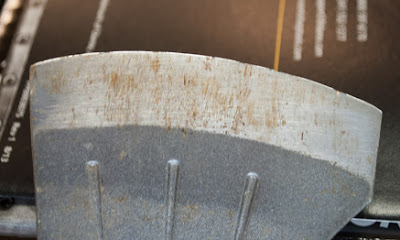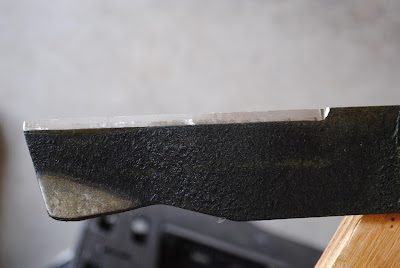 |
What’s your life game? I discovered long ago my life plan involves knives. Folding knives, fixed blades, pocket knives, survival knives, tactical knives, it doesn’t matter to me. As long as it has an edge, I’m interested. Join me as I write about life, knives and the things seen from the knife edge.
Monday, May 15, 2017
Friday, April 28, 2017
Boker Mini Kalashnikov Auto
Boker knives are some of the hidden gems in the knife
market. Mostly because they don’t have
the advertisement clout others do. But
smart thinkers and cagey knife users should be thinking about the Boker brand.
Boker traces its roots to tool manufacturing the 1800s in
Germany. Swords were the name of the
game, but they diversified into other edged products. The family owned company sent representatives
to America and opened up manufacturing in America. They both shared the “Tree Brand“ logo.
During the Second World War the Solingen plant was destroyed
and Boker USA took control of the trademark.
In the 1950s the German factory was rebuilt. Over the years the American company
closed. The German company changed hands
but in 1986 Boker reacquired the rights to the American brand and established
facilities in Denver, Colorado.
Boker has manufacturing
in Germany (of course!), Argentina, Taiwan and China and now in the
USA. They produce three basic levels
depending on the price point: Boker, Magnum and Boker Plus.
I once did a special order of a special knife to commemorate
the customer’s son-in-law’s military promotion.
It was a beautiful Damascus bladed folder. The blade was carved from 300-fold forged
Damascus steel from the barrel of a German Leopard 1 tank.
The knife came in a nice wood presentation box with the
instruction and history in German. The
buyer was very happy, as his son-in-law spoke German for the Army. I have a friend who spoke German for the Army;
he was a spy. I didn’t ask any more
questions.
So if your introduction and thoughts about Boker are from
the Magnum $7 knife pile, think again.
 |
| Boker's switchblade |
I just got my hands on the Boker Mini Kalashnikov auto. I’m very impressed. Here’s the stats:
Blade: drop point
Steel: AUS8
Blade Length: 2.5
inches
Handle length: 3.5
inches
Weight: 2.1 ounces
Handle: reinforced
nylon
Country of origin: Taiwan
The Boker website claims the handle is aluminum but they
also claim the blade is wood. Hummm,
someone’s website has been hacked.
 |
| Clip side |
The blade shows the same powerful spring action I’ve seen in
Benchmade autos. Block the blade from
completely opening and when the obstacle is removed, the spring still has
enough force to finish the opening and lock the blade in place. The pocket clip is reversible and the handle
sports a lanyard hole.
 |
| The finger grooves really provide a grip so you can concentrate on using the knife and not holding the knife |
The finger scallops fit my hand pretty good for a small
knife. And between the scallops and the
jimping on the blades spine and handle you get a very good grip. The blade release is a basic plunge lock
system. This system has been used for
many years and is very dependable if you keep it clean. But isn’t that true of all machinery?
 |
| The open back allows for easy cleanup and makes oiling the spring much simpler. |
I suspect it uses a coil spring and the knife has Torx
screws so you can replace the spring if necessary.
I have come to like auto more and more. I don’t suspect they open any significantly faster
than the assisted or many of the tactical knives. But I do think pushing a button is a
gross motor skill and doesn’t require the fine motor skills which are lost
under the influence of fight/freeze/flee conditions.
I wish I could take it for a drive, but it isn’t mine. I have no doubt it would serve me well.
It retails for about $55 but you can get it for less if you shop
around. I’ve got two for sale, but
that’s another story.
Tuesday, April 25, 2017
Ready…. Set… Count!
Guinness records just established
a category for the world’s largest knife collection. They decided it takes at least 2100 unique
knives to define a large collection. So
now you know. If someone asks you if you
have a large collection the answer is mostly likely “no.”
The current record holder is Luis
Bernardo Mercado (Fremont, CA.) who comes in at 2175. Congratulations, Luis!
These knives represent 6
continents, 29 countries and 400 different brands and custom makers and 50
years of collecting.
The process of documenting the
size of your collection isn’t trivial.
Perhaps that’s a new category for Guinness: most difficult
documentation. Of course as soon as you
win this one, it’s likely the documentation of your documentation would cancel
out your win.
Luis started collecting at five,
so it may be too late for some of us to attempt to claim that title for ourself,
but he’s confident the title is only transitory as he’s the first to claim it.
Monday, April 24, 2017
Spring Sharpening
With the arrival of warm weather my
grass has redoubled its effort to make my yard an uneven carpet of green. Before getting the lawn mower out I needed to
resharpen the blade.
I’ve stopped taking it to a lawn or
garden center and getting the blade resharpened. I bought a little attachment for my Dremel
tool. The attachment screws on to the
front of the tool and come with a special diameter grinding stone. A guide helps me hold the blade angle and
lets me grind out the really dull and damaged
areas.
 |
| Start your sharpening! |
I clamp the blade down on a sheet
of plywood and run the Dremel grinding stone over the old edge several times
until the old discoloration is gone and so are the majority of nicks and gouges
in the edge. I use the plastic guide to hold
the angle, but perfection isn’t required.
A fine dry stone pulls the wire edge off the other side. I should mention my mower blade is a classic
chisel grind. I test the sharpness by
shaving the edge of the plywood board I use as a work station.
The last step before reinstalling
the blade is to check the balance. If one side of the blade was significantly
heavier, the mower would vibrate and damage itself, perhaps even break a blade. The heavy side just gets another pass and a
second balance check. Repeat as
required.
Since I was in sharpening mode I
got out my Ken Onion Work Sharp blade grinder and sharpened my hatchet.
As you know I recently discovered
my SOG camp hatchet was extremely dull but luckily my friend Derrick brought
his Gerber hatchet. Having a fire in the
fireplace as part of the evening’s entertainment and as a back-up to winter
storm power failures is a nice luxury.
The price you pay for this is splitting wood into suitable burning
size. A sharp hatchet is required and
mine needed a good sharpening.
 |
| Every fire deserves a sharp hatchet |
 |
| Before sharpening, note nicks in blade |
The blade looked good so I changed
to a medium grit. That took a little
more off and I was satisfied. But how
you really tell if your axe is sharp?
I decided performance was the only
way. I grabbed a section of a
landscaping tie and a length of pine 2X4 and tried it out. I was less than impressed.
The hatchet didn’t cut the wood
fibers, but crushed them. Definitely not
sharp. I changed the angle to 10 degrees
and repeated the process. This angle
worked better.
 |
| bye-bye nicks! |
While I was touching up the edge I
noticed the cutting edge wasn’t centered in the blade’s secondary bevel. This typically happens when one side of a
blade is sharpened more than the other.
I played with it for a while and discovered one side the bevel is flat
ground while the other is slightly convex.
This bevel asymmetry is the cause for the non-centered edge.
I worked on the edge a bit more and
called it finished. It’s not perfect,
but it’s sharper than it was. Chopping
pine boards may not be the best material to judge hatchet performance. I’ll look around for actual logs to try it
out.
Subscribe to:
Posts (Atom)
